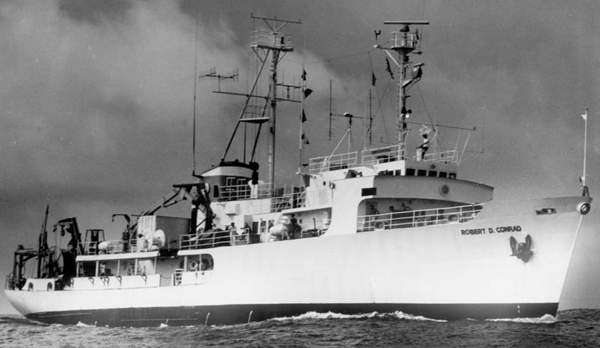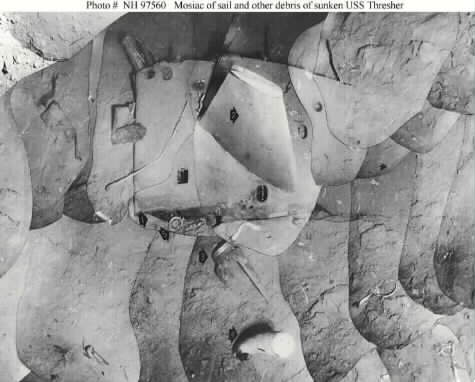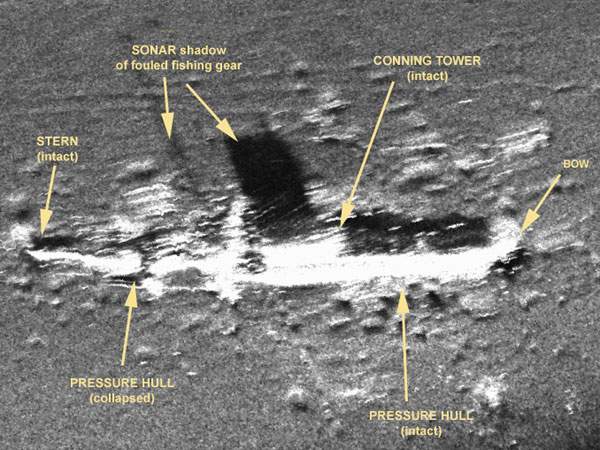There’s another fun story about cold war submarines, which appears to have now been (semi-?) confirmed. Lots of story hasn’t come out, yet, but it probably will, within the next fifty years.
Woods Hole Oceanographic Institute has served as a cover/test-bed for lots of spooky undersea cold war stuff. Bathyscaphes like Trieste and Alvin were often involved (or, more often, it appears they had unnamed sister ships) in looking for nuclear weapons that were lost at sea, or examining Soviet wrecks. [At this point, I will say: this is not a story about Project Azorian; that’s for another time]
Robert Ballard did a great deal of deep sea exploration, and was in the US Navy in 1967-? – there’s a good likelihood that he was involved with lots of spooky stuff; that was around the time that the US SOSUS line was being deployed (Woods Hole was involved in the initial research that led to SOSUS) to be fair, it sounds like a lot of this stuff was “hey, look, since you’re going down there anyway…” [sosus] It’s currently unknown what kind of deep-sea listening is going on, but there are accounts that SOSUS was part of what triangulated the sinking of the USS Scorpion, an American nuclear submarine that sank in 1968. [wik] The USS Thresher sank in 1963 and, again, SOSUS data was useful for analyzing what may have happened to the Thresher.

Robert Conrad
Pictures of the wreckage of the Thresher were taken in 1964 by (allegedly) the Lamont Doherty Earth Observatory’s seismographic survey ship Robert Conrad. [conrad] The US has had a fairly impressive array of “research” ships – most famously the Hughes Glomar Explorer but also, the USNS Mizar,[wik] which appears to be the first ship that sported side-looking aperture radar; the Mizar appears to be the ship that mapped the location of the Soviet K-129 [Project Azorian] – Mizar and USS Halibut, the same sub that laid the taps on the Soviet Ohkhotsk cable, appear to have been interesting and busy ships, indeed. But Mizar‘s day was in the mid-70s and in the 60’s it was the Conrad that appears to have produced the photos of Thresher‘s wreckage, presumably with some kind of towed camera.

Composite image of Thresher’s sail, allegedly produced by the Robert Conrad using technology that has not been described (obviously, a camera)
When the Scorpion sank, Mizar was instrumental in finding what was left of it, and the Trieste bathyscaphe (or its classified sister-ship) appears to have been dropped to photograph the wreckage. Look at the improvement in imagery in just a few short years!

This image is described as “taken when the Mizar located the Scorpion“
So, that’s enough preparatory throat-clearing. You can see that the US intelligence community had some very powerful capabilities in the form of the Mizar and its various friends.

The Atlantic is huge (and deep) and it’s not as if one simply sails about scanning the bottom. However, Robert Ballard – who is noted for finding RMS Titanic and Bismarck – has finally come out openly and said that the intelligence agencies’ searching for Scorpion and Thresher also turned up other game:

Thresher, Scorpion, Titanic
Ballard says he reasoned that since Titanic broke in half, it would have left a pretty large debris field. He doesn’t say Mizar found it, but: [NationalGeo]
Ballard met with the Navy in 1982 to request funding to develop the robotic submersible technology he needed to find the Titanic.
Ronald Thunman, then the deputy chief of naval operations for submarine warfare, told Ballard the military was interested in the technology – but for the purpose of investigating the wreckage of the U.S.S. Thresher and U.S.S. Scorpion.
Since Ballard’s technology would be able to reach the sunken subs and take pictures, the oceanographer agreed to help out.
He then asked the Navy if he could search for the Titanic, which was located between the two wrecks.
“I was a little short with him,” said Thunman, who retired as a vice admiral and now lives in Springfield, Illinois. He emphasized that the mission was to study the sunken warships.
That’s a nice story, but it sounds like the Thresher and Scorpion were located by Mizar in 1963 and 1968, respectively, thus the time-line placing Ballard’s Titanic hunt in 1982 sounds like a head-fake to me. I wonder if the spooks had found Titanic back in the 1970s and they knew, and Ballard knew, where it was all along.

The Navy has visited Thresher intermittently, because its nuclear reactor is still sitting there, intact (supposedly) on the bottom. There are references and photos credited to a robotic drone, in 1999. [nav] I guess it’s reassuring (?) that they’re keeping an eye on the reactor. I don’t know what happened to the Scorpion‘s reactor.
Mizar was a very busy ship, indeed. It appears to have also taken part in the search for the nuclear weapons that an American B-25 lost in 2,500 feet of water off Palomares [wik] The capabilities of the Mizar are not described anywhere I am aware of but it must have been pretty impressive, even in 1975; accounts of Project Azorian indicate that the Mizar‘s imaging was good enough that the CIA was able to accurately measure the size of the pieces K-129 broke into, from 16,000 feet down.

Alvin, Woods Hole Oceanographic and Nuclear Weapons Recovery Institute
Alvin was also involved in recovering the Palomares nuke.
In Blind Man’s Bluff [amazon] there are indications that Mizar was involved in the search for Scorpion along with another more mysterious thing called NR-1. I am thrilled to death that I decided to write about this topic, because some searching around uncovered a whole website devoted to NR-1 which I intend to devour at leisure. [nr-1]
This is an image of a sunken American sub USS S-09, [lyman] which was taken by the Lyman Rutledge Marine Laboratory – the folks who operated the Conrad. Is this an indication of the kind of imaging the Conrad was capable of?

UK.gov puts Suffolk 7-year-old’s submarine design into production
Reginald Selkirk@#1:
Thanks for that, that made my day! I hope that kid goes far. Much props to them for supporting him.
To be honest I can’t see anything in the Scorpion image. To me it looks more like a microscope slide, perhaps contaminated water with bits of dirt and metal particulates, not a subsea debris field (?). As for the thresher, are those odd curvy lines a product the mosaic or has the seafloor just decided to look weird and unnatural because no human would ever see it to complain? I assume it’s the former, which makes me glad that image processing nowadays doesn’t require actual glue and scissors for cutting and pasting.
Unkind as I am, I might suspect they’re just be doing it to see what happens. I’m sure the US military would like to know what happens to an abandoned nuclear reactor in the sea, and what happens to said sea when said reactor surrenders to it. If there was some genuine concern* there’d probably be some attempt to salvage it** or (Apollo-13 style) dispose it even more remotely.
Now that’s a little unf… ahem, never mind.
And once again reading something like this it hits me how idiotic it is to maintain nuclear arsenals. Just having an institue for recovering lost nuclear weapons makes humanity sound like a borderline suicide case, getting up every morning, staring at the noose and then deciding, “Maybe tomorrow”, before putting the rope, neatly coiled, back into its drawer.
*i.e. concern that it might irradiate their precious assets. Yes, unkind.
**Raising the question what you do with salvaged broken nuclear tech***
***Raising the question why you’re playing with nuclear tech you don’t know how to dispose
P.S.: I think the [Project Azorian] link decided to stay home.
I guess it’s reassuring (?) that they’re keeping an eye on the reactor.
Why? It’s not like politicians care about removing radioactive waste from ocean floors. After all, politicians have intentionally dumped tons of chemical and radioactive waste in seas and oceans. This shit https://www.economist.com/blogs/easternapproaches/2013/11/baltic-sea particularly bothers me, because I happen to live next to it. But this is happening all over the world, see: https://en.wikipedia.org/wiki/Ocean_disposal_of_radioactive_waste